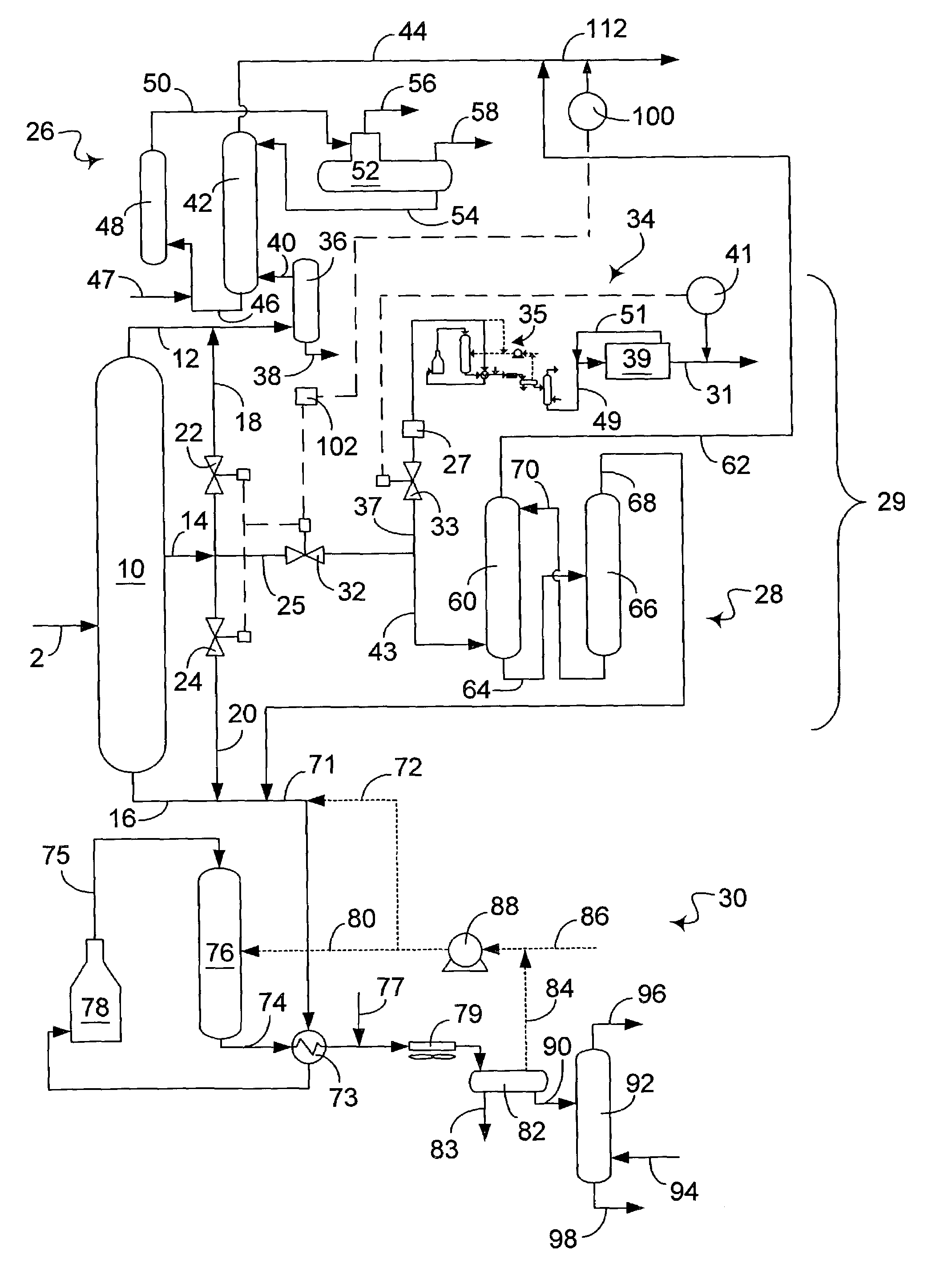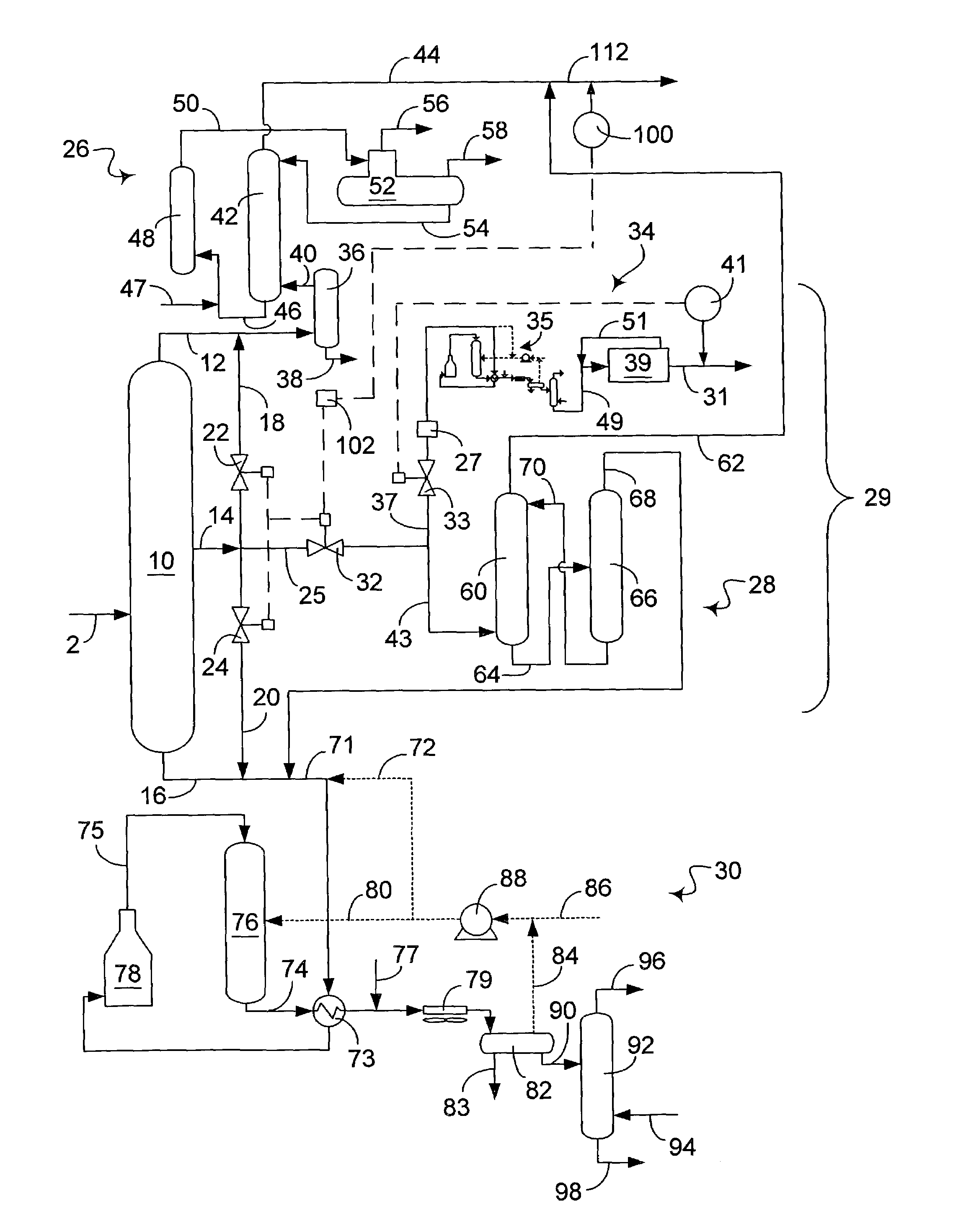Process and apparatus for removing sulfur from hydrocarbons
a technology of hydrocarbons and sulfur, applied in the petroleum industry, hydrocarbon oil refining, and refining to eliminate heteroatoms, etc., can solve the problems of increased cost and difficult detection of thiophene in fcc naphtha, and achieve the effect of reducing operating expenses and delaying the capital expenditure necessary
- Summary
- Abstract
- Description
- Claims
- Application Information
AI Technical Summary
Benefits of technology
Problems solved by technology
Method used
Image
Examples
example 1
[0076]In Example 1, the post-fractionation treatment is operated to ensure that the total contribution of sulfur compounds to the gasoline pool is no more than 10 ppm by weight of the total gasoline pool. Because the FCC gasoline will contribute one-third of the gasoline in the pool, the three post-fractionation streams can contribute no more than 30 ppm by weight. Table 1 gives the distribution of sulfur and olefin contributions in the feed and from each post-fractionation stream and the total sulfur and olefin contribution to the gasoline pool for Example 1. In Example 1, the total olefin contribution of three streams is 24.25% of the product which is down from 30% in the feed.
[0077]
TABLE IMercaptanHydro-OxidatedExtractedtreatedS Distribution (ppm)FeedLightMiddleHeavyLightMiddleHeavyMercaptans400180200200210Disulfides200200510Thiophenes400101002901010Benzothiophenes1500001500000Total2320190320181015410Pool contribution773.363.3106.7603.351.33.3Olefins %, pool basis30101551014.250T...
example 2
[0078]In Example 2, the same feed was subjected to the same treatment, but the total sulfur contribution to the gasoline pool is allowed to reach 30 ppm which means the FCC gasoline could contain 90 ppm of organic sulfur compounds. To exploit the additional sulfur allowance, a portion of the middle stream is allowed to bypass the extraction process and is mixed with the treated light and heavy streams and the treated remainder of the middle stream. The use of such a bypass operation reduces the volume of middle stream to be treated, and hence reduces the size and cost of extraction process required.
[0079]
TABLE IIMercaptanHydro-OxidatedExtractedBlendedtreatedS Distribution (ppm)FeedLightMiddleHeavyLightMiddleMiddleHeavyMercaptans4001802002001.623810Disulfides20020050.813.80Thiophenes40010100290100.81190Benzothiophenes15000015000000Total23201903201810153.2460.810Pool contribution773.363.3106.7603.351.0820.273.3Olefins %, pool basis30101551011.542.850Total olefins % in product24.39Pool...
example 3
[0081]In Example 3, a feed with a lower sulfur concentration is subjected to the same treatment as in Example 2 with an applicable maximum gasoline pool sulfur concentration of 30 ppm.
[0082]
TABLE IIIMercaptanHydro-OxidatedExtractedBlendedtreatedS Distribution (ppm)FeedLightMiddleHeavyLightMiddleMiddleHeavyMercaptans16090502000.23526.510Disulfides10010050.2355.30Thiophenes2001060130100.28231.80Benzothiophenes700007000000Total1070100120850150.75263.610Pool contribution356.733.340283.350.25121.23.3Olefins %, pool basis3010155106.69757.950Total olefins % in product24.65Pool sulfur ppm in product29.78
[0083]In Example 3, 53% of the middle stream can be blended in the gasoline stream without further processing. Furthermore, the olefin concentration increases to 24.65.
[0084]Examples 4–6 use the same flow scheme as in Examples 1–3 with the exception the feed to the fractionation column is subjected to a non-extractive mercaptan oxidation treatment and the low boiling stream is not subjected ...
PUM
 Login to View More
Login to View More Abstract
Description
Claims
Application Information
 Login to View More
Login to View More - R&D
- Intellectual Property
- Life Sciences
- Materials
- Tech Scout
- Unparalleled Data Quality
- Higher Quality Content
- 60% Fewer Hallucinations
Browse by: Latest US Patents, China's latest patents, Technical Efficacy Thesaurus, Application Domain, Technology Topic, Popular Technical Reports.
© 2025 PatSnap. All rights reserved.Legal|Privacy policy|Modern Slavery Act Transparency Statement|Sitemap|About US| Contact US: help@patsnap.com


